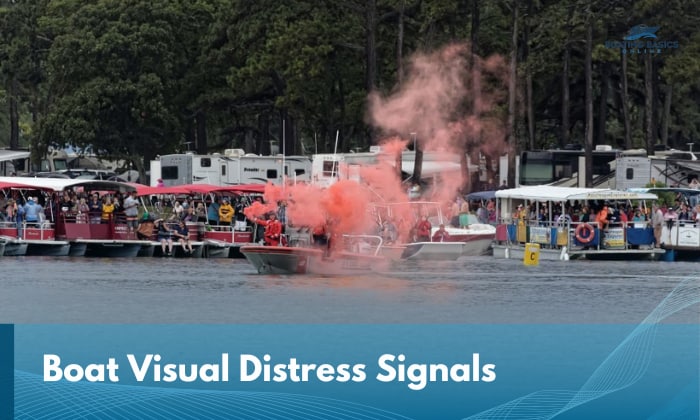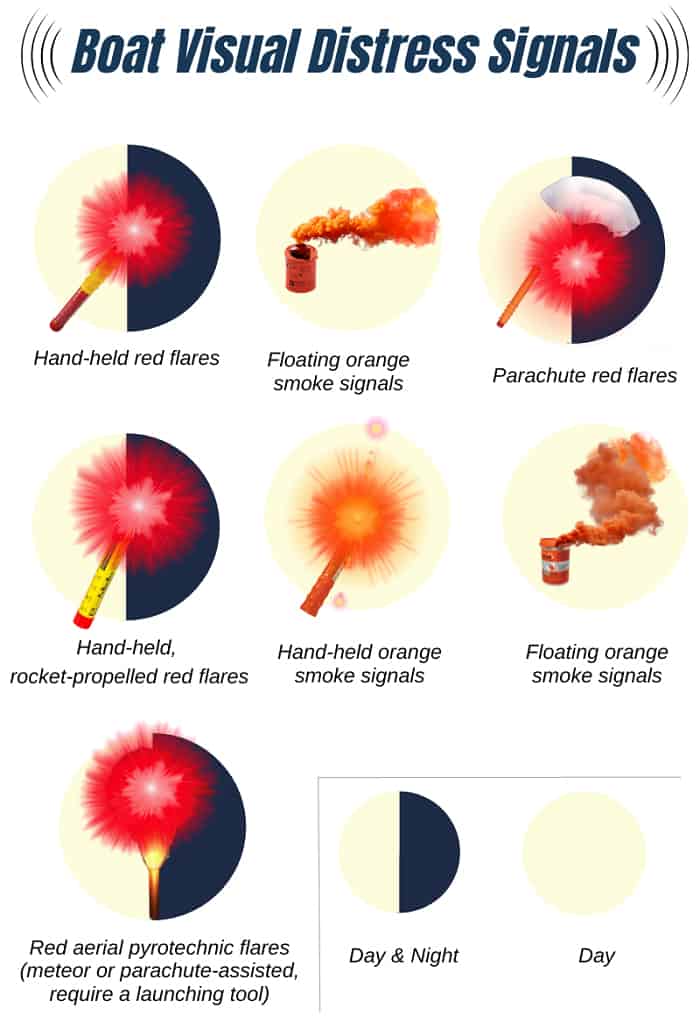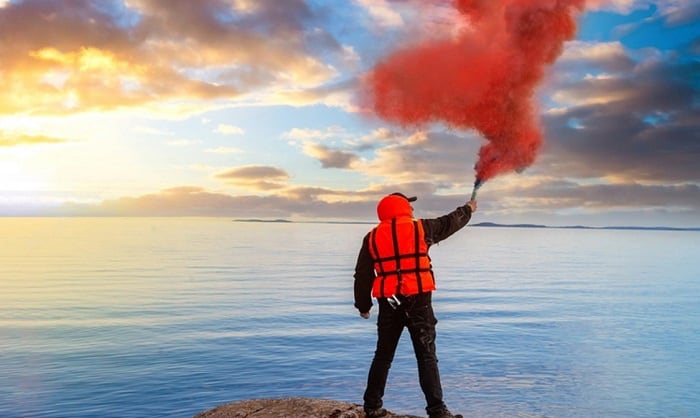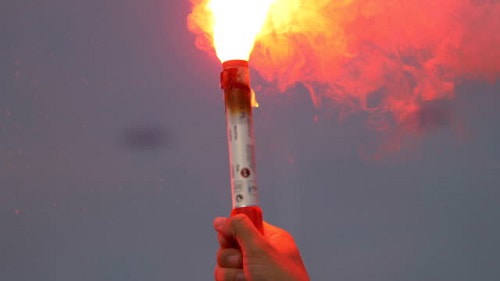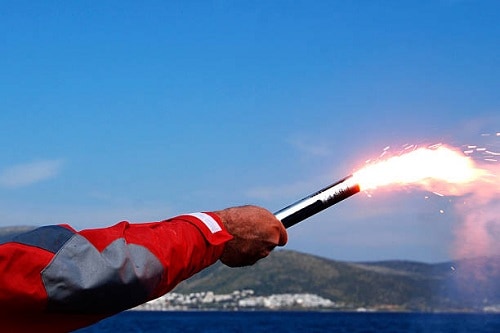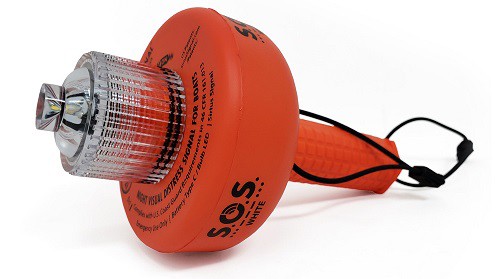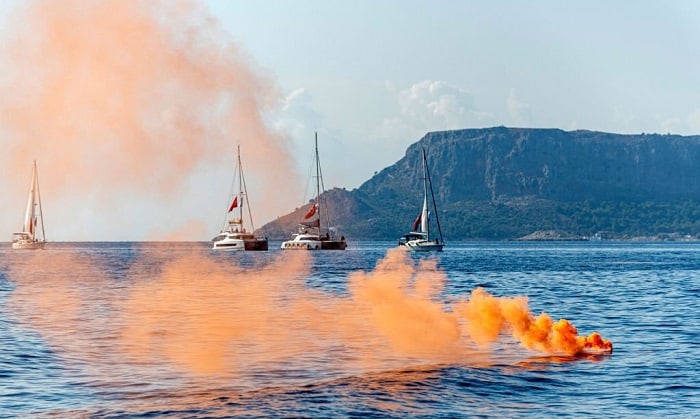It’s every boat owner and operator’s responsibility to use the correct boat visual distress signals during emergencies. As their name readily suggests, these are signals designed to quickly catch the eye should a vessel issue a call for aid.
They come in various pyrotechnic forms, the most common of which are aerial red flares, aerial orange smoke flares, and parachute flares. Non-pyrotechnic VDS include electric distress lights and orange flags.
Table of Contents
Definition of Visual Distress Signals for Boats
Given their ability to quickly attract attention, visual-based boating distress signals are defined as tools and devices used to make a watercraft easy to detect and locate in an emergency.
VDS boating should remain highly visible because, day or night, you should always be able to call for aid during times of crisis. As such, your choices shouldn’t be limited to hand-held flares only and other pyrotechnic signaling devices.
I will expound on each type of distress signal on a ship as follows. But first, let’s look at the legal guidelines for these must-have, life-saving equipment.
Legal Requirements for Distress Signals
Did you know that visual distress signals just became mandatory for recreational boaters on January 1, 1981?
The regulation made it clear that this requirement applies to all boats owned in the US and used on its coastal waters (the Great Lakes included), territorial seas, and waterways connected to the Great Lakes and the territorial seas.
There’s a limit to it, though. It only applies “up to where the waters are less than two miles wide.” Certain boats are also exempted to carry these signaling devices, specifically during the daytime, such as:
- Recreational boats smaller than 16 ft.
- Vessels being used in races, marine parades, and regattas.
- Open sailbfoats without propulsion machinery and less than 26 ft.
- Boats driven by manual propulsion.
They MUST have properly functioning visual distress signals during nighttime, though. These are the other VDS requirements that you should be aware of:
- Having USCG approved visual distress signaling tools readily accessible and in working condition.
- Only using signals whose full serviceable life hasn’t already elapsed.
- At least one electric distress light should be available for nighttime use.
- At least one orange flag must be available for daytime use.
In the following table, I’ve listed down the USCG-approved flares required for boating to know whether they’re valid to be used during the day, night, or both, and their distinct approval number under legal guidelines. You need to bring at least three (3) of all these types of VDS, assuming your vessel isn’t exempted.
| Type of Visual Distress Signal | Required Time of Usage | Number Marked on Signaling Tool |
| Hand-held red flares | Day & Night | 160.021 |
| Floating orange smoke signals | Day | 160.022 |
| Parachute red flares (require a launching tool) | Day & Night | 160.024 |
| Hand-held, rocket-propelled red flares | Day & Night | 160.036 |
| Hand-held orange smoke signals | Day | 160.037 |
| Floating orange smoke signals | Day | 160.057 |
| Red aerial pyrotechnic flares (meteor or parachute-assisted, require a launching tool) | Day & Night | 160.066 |
If you want to know more about the different types of visual distress signals and their specific usage and limitation, as well as how combinations function, read on.
Various Types of Visual Distress Signals
Keep in mind: when using any type of hand-held flare or smoke signal, you need to wear gloves as they can get particularly hot over time.
1. Hand-held parachute flare and aerial red meteor flare
These are characterized by their long or short cylindrical shape with a red cap on the bottom. The cap covers the toggle that ejects the rocket or meteor.
They’re versatile and reliable to use regardless of the time of day. However, most have the downside of lasting only for a while, just one minute on average.
Safety tips when using flares:
- Be sure to point them downwind.
- Stretch out your arms as you hold them away from you.
- Refrain from looking directly at the flare.
Make sure you’re not pointing it toward you or any other person before pulling the toggle!
2. Floating or hand-held pyrotechnic orange smoke signal
Modern-day smoke signals come in compact cans. Once deployed, they emit a distinctly orange-hued smoke that indicates your position and wind direction for aerial rescuers. The smoke normally lasts for 3 minutes.
It can be deployed in three simple steps:
- Remove the plastic cap.
- Point the top away from you then pull the tab firmly from the can.
- Promptly throw it overboard.
3. Non-pyrotechnic VDS
Most non-pyrotechnic VDS last longer than their pyrotechnic counterparts. It’s better if they’re used together.
- Electric distress light
International distress signals can be sent using a gadget as straightforward as an electric distress light. These S.O.S. lights can be used as a substitute for pyrotechnic flares.
Once on, they can emit the S.O.S. signal for a relatively longer time than flares (more than 2 days, to be exact).
Here’s a video explaining how to use one:
- Orange flag
Once you raise an orange flag on a boat, you immediately make it known that your vessel is in distress. It has to be the right size which is 3’ x 3’. With the orange color for the background, a black box should be printed on the right, while a black circle should be positioned on the left.
Now, if you chanced upon visual distress signal tutorial videos in the past, you may wonder, “Why aren’t mirrors and sea marker dyes part of the list?” Let me explain:
- Mirrors aren’t officially recognized by the US Coast Guard as a VDS, thus, aren’t required. However, they don’t deny that it can still be used to attract attention in times of danger – much in the same way that waving your arms does.
- Though not required, a sea marker dye can be helpful in quickly attracting air rescue with its effective use of bright colors.
How to Combine Pyrotechic and Non-pyrotechnic Vds
- You can opt for a red flare trio, which can be used both day and night to widen your reach and signal the seriousness of your situation.
- Three orange smoke signals can create a more visible cloud during the daytime.
- A flare and light combo of one hand-held red flare and two parachute flares can be used.
- Last but not least is a smoke and light mix of handheld orange smoke, two floating orange smoke signals, and an electric distress light will do for both daytime and nighttime
Storage and Maintenance Guidelines for Distress Signals
- Most boat emergency signal devices should be stored in a dry location. Waterproof storage boxes and cabinets are preferred.
- Mark the boxes properly so anyone not familiar with your boat will be able to promptly tell that they contain VDS.
- Keep them accessible but away from
Conclusion
It’s truly a comfort for any boat operator to know that there are more than a handful of reliable and innovative boat visual distress signals available in this day and age. Red flares, orange smoke signals, S.O.S. lights, and flags designed with ease of use in mind continue to save lives as we speak.
Whether you’re using a parachute flare or a hand-held smoke signal (or both), be sure to follow the exact instructions I’ve laid out here or the one provided by the manufacturer.

“I am James Harvey – founder of Boating Basics Online. It is established with the drive to help out first-time boaters, which are those desiring to explore their way through the water. So if you are new to boating, start from here with me. “

